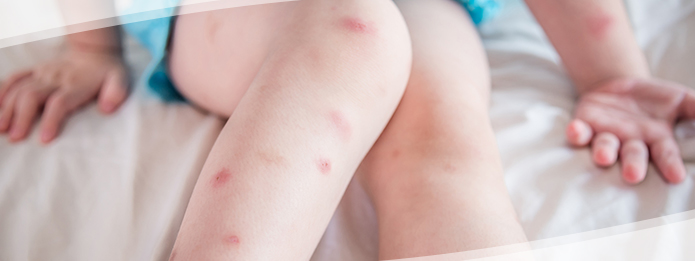Why Can’t We Feel Bed Bug Bites?

The realization that your home is infested by bed bugs can be a shocking discovery. In the early stages of infestation, their presence is not obvious, and only gradually do the little insects make themselves known through signs such as brown spots on sheets or tiny exoskeletons on the floor. Sometimes, however, the first clues are mysterious bites on the arms and legs of family members that no one can remember receiving.
Why Don’t Bed Bug Bites Hurt?
Unlike familiar insects like mosquitoes, ants, and fleas, bed bugs can bite without causing pain. Most insects produce saliva with a similar function as the saliva in a human’s mouth, which is to lubricate food before swallowing. Bed bug saliva is uniquely adapted to the insect’s lifestyle, however, and contains 46 special chemicals that human saliva does not.
One of these is the anti-clotting agent called apyrase. This substance allows a victim’s blood to flow freely while the insect feeds. Another substance is nitrophorin, a vasodilator, which causes blood vessels to open and release more blood. Lastly, bed bug saliva contains an anesthetic to numb the skin so that people are not aware of being bitten.
Do Bed Bugs Have Teeth?
Bed bugs are members of the insect order Hemiptera, which also includes insects like aphids and cicadas. Unlike cicadas, bed bugs cannot fly or jump, but rather crawl on the ground like an ant. One feature exclusive to all members of this group is the presence of piercing and sucking mouthparts. While they don’t have teeth per se, they do have thin, sharp structures known as stylets inside their mouths. Most hemipterans use their mouth structures to suck juices from plants, but bed bugs use theirs to pierce the skin and suck the blood of humans and other warm-blooded animals.
What do Bed Bug Bites Look Like?
The basic mark left by a bed bug is a tiny hole in the skin (known scientifically as a “punctum”) where the insect’s piercing mouthpart was inserted. Up to almost two-thirds of people have no significant reaction to these bites, so the tiny piercings often go unnoticed at first.
Over time, many individuals become sensitized to the bites and begin to notice red marks on their face, arms, and legs that resemble those from scabies or chiggers; other people will notice these marks right away. Multiple bites often occur in a straight line, and occasionally in groups of three that are colloquially referred to as “breakfast, lunch, and dinner.” After the anesthetic from the insect’s saliva wears off, the bites can become quite itchy.
Are the Bites Dangerous?
Researchers have identified more than 40 different disease-causing organisms in and on bed bugs. Fortunately, there are no cases of the disease being transmitted from the insects to their human hosts. The danger of the bites is from secondary reactions such as skin infections caused by scratching. These infections sometimes can last for several weeks and may leave scars. In rare cases, victims have reported symptoms such as fevers, hives and severe allergic reactions.
How Can I Protect Myself from Bed Bug Bites?
A bed bug infestation should not be taken lightly. A single female transported into the home on clothing or luggage can lay hundreds of eggs, and before you know it, they can infest not just your bed but any crack in your home the width of a credit card or wider. Once they are established, there is no proven method to keep them from biting you while you sleep.
If you suspect you are getting bitten at night, call Truly Nolen for a home inspection. In the case of bed bugs, what you don’t feel can hurt you.